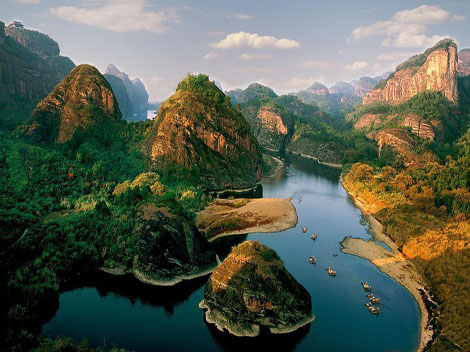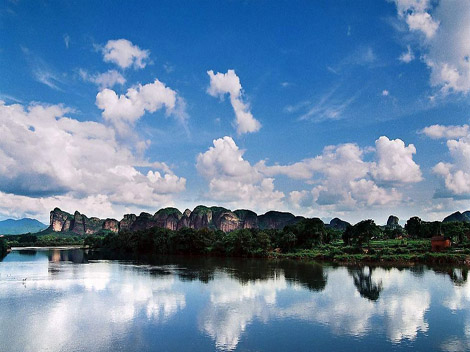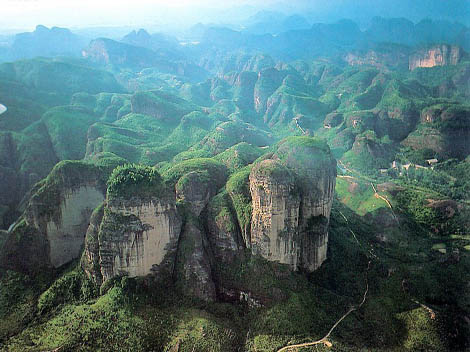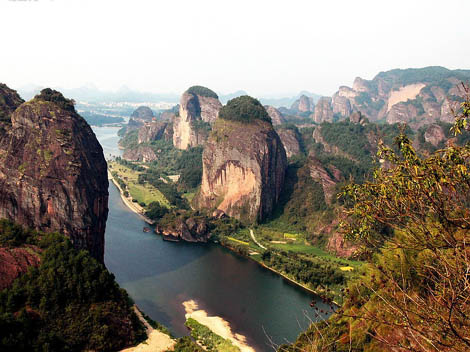more>>More News
- National Day
- ways to integrate into Chinese style life
- Should they be in the same university with me?!!
- Chinese Ping Pang Legend: the Sun Will Never Set
- A Glance of those Funny University Associations
- mahjong----The game of a brand new sexy
- Magpie Festival
- Park Shares Zongzi for Dragon Boat Festival
- Yue Fei —— Great Hero
- Mei Lanfang——Master of Peking Opera
Dragon and Tiger Mountain (Longhu Mountain) in Jiangxi
By admin on 2015-01-19

Sixteen kilometers away from Yingtan City to the southwest, Longhu Mountain Resort is a nationally famous scenic spot known as a Mountain of Deity and Earthy Paradise, which covers around 200 km2 with semitropical humid monsoon climate and an annual mean temperature of 18.1 ℃ . The main scenic spots include Shangqing Palace, Yingtian Mountain, Mazu Cliff, Hongwu Lake, Fairy Water Cliff, and Longhu Maintain. The Taoism culture experiencing a very long history, beautiful and unique green hills with wandering streams and springs among them, and the mysterious cliff tombs that can not be explained by modern science are the three most amazing and attractive points among the natural and cultural sceneries in the Resort.
Taoism of China originated in this place, Longhu Mountain.


Longhu Mountain was formerly named Yunjin Mountain. In the middle of Eastern Han Dynasty (25 A.D.-220 A.D.), Zhang Daoling, the first Heavenly Master (title used by Taoists for the Head of Taoism) settled down here and began to make Nine-sky Pills of Immortality. “ A dragon and a tiger appeared when the Pills are made, so the Mountain was renamed as Longhu Mountain (Chinese Characters “ 龙(Long )" and “ 虎(Hu)" means dragon and tiger in English” ). The Title of Heavenly Master Zhang passed on for 63 generations, witnessing a Taoism sect which experienced the longest history of more than 1900 years among all single-name sects of this religion. So there is an old saying in China, “Confucius represents the North while Heavenly Master Zhang the South.” The untouched Shangqing Heavenly Master Residence dating back to Han Dynasty, which was named as “Great True Man (a Taoist title)’s Residence”, currently covers over 30 thousand m2 and remains under good protection. Established in Eastern Han Dynasty, the Great Shangqing Palace was considered as a divine place where deity received their duties and Heavenly Master Zhang Daoling cultivated himself for immortality. In the period when Taoism was quite prosperous, there were 91 palaces, 80 temples 50 residences, 24 halls, and 36 compounds in all. The Subjugating Evil Well in the Vanquishing Demon Hall is where the 108 warriors came from in the Outlaws of the Marsh, a Chinese classical masterpiece by Shi Nai’an, and remains undamaged.
Longhu Mountain can be classified as typical Danxia Landform in China. There are 99 peaks, 24 cliffs, 108 natural and cultural scenic spots, and over 20 legendary wells and pools, among which springs and falls are scattered, adding enchanting beauty to the Resort. Like a jade ribbon, Luxi River stretches itself from south to north, linking Shangqing Palace, Heavenly Master’s Residence, Longhu Mountain, Fairy Water Cliff and other spots. Surrounded by scenic hills and springs, the ten major beauties in the core area indeed seem more refreshing and exciting.

Built in the Spring and Autumn Period and the Warring States Period, the Cliff Tombs here can date back to 2600 years ago. Known as a natural archeological museum which is very rare in China even in the world, the Tombs have attained a worldwide fame for their long history, large scale, rich antiques, and unique shapes.
With Yingtan-Xiamen, Anhui-Jiangxi, and Zhejiang- Jiangxi railways and 206, 320 national highways crossing this area, the traffic conditions are convenient here. Besides, you can take waterways to Poyang Lake, the biggest Transportation Center in the south of the Yangtze River. The Resort is only 120 km2 away from the Changbei Airport in Nanchang, the capital of Jiangxi Province and 16 km2 from Yingtan, one can take No. 8 bus in the city to reach here directly.
- Contact Us
-
Tel:
0086-571-88165708
0086-571-88165512E-mail:
admission@cuecc.com
- About Us
- Who We Are What we do Why CUECC How to Apply
- Address
- Study in China TESOL in China
Hangzhou Jiaoyu Science and Technology Co.LTD.
Copyright 2003-2024, All rights reserved




 Chinese
Chinese
 English
English
 Korean
Korean
 Japanese
Japanese
 French
French
 Russian
Russian
 Vietnamese
Vietnamese
